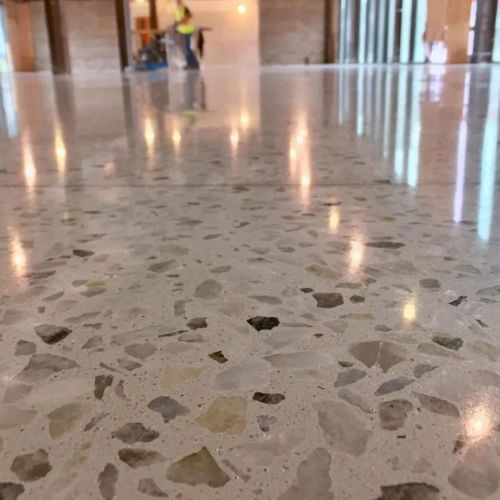What Are the Best Techniques to Achieve High-Quality Polished Exterior Concrete Finishes?

Strong 8k brings an ultra-HD IPTV experience to your living room and your pocket.
Polished concrete is getting very popular as it is durable and attractive, both for interior and exterior surfaces of buildings and structures, while it is relatively easy to maintain. Though polishing concrete has been very much in vogue as a practice for very many years for the interior, demand for exterior polished concrete has picked up in recent times. However, it offers a surface that has withstood the elements and lasted.
High-quality polished exterior concrete finishes, however, require some techniques and attention to detail. The whole process includes preparation, grinding, polishing, and sealing that not only make the final surface beautiful but also resistant to weathering, staining, and wear. Below, we will explore the key techniques needed to achieve the best polished exterior concrete finishes.
1. Proper Surface Preparation
Preparing the surface well is the first step to achieve a high-quality polished exterior concrete finish. This may be the most important step in the whole process because the quality of the preparation directly affects the end result.
Cleaning the Surface
Before even polishing, it is important that the concrete is cleaned. All the dirt, debris, grease, or oil stain should be removed. Pressure washing or using specialized concrete cleaners could help achieve this clean, contaminant-free surface. This is important because the contaminants left on the surface would interfere with the polishing process and affect the finish.
Repairing Cracks and Imperfections
Once the surface is clean, it is important to attend to cracks, chips, or other imperfections on the concrete. The concrete may need to be filled up with a concrete patching compound depending on the level of damage. A smooth, even surface is important in achieving a polished finish.
Densification
After the surface is repaired, the next step is to densify the concrete. Concrete densifiers are chemical solutions that react with the calcium hydroxide in the concrete to make it harder and more durable. Densifying the concrete also helps improve the polishing results by reducing porosity and enhancing the final shine.
2. Grinding the Concrete
Once the concrete is ready, grinding begins. Grinding is the most important step of polishing because it removes the top layer of the concrete and evens out the imperfections on the surface. The goal here is to create an even surface that will be ready for the next polishing stages.
Selecting the Right Grinding Equipment
Finish should leave a shiny or smooth outer, and specialized use of the grinder with the flooring tools consisting of diamond emtried onto to break it surface without scratching away or gouge. Starting coarser is suitable for diamond grains and continue your way until obtaining the perfect degree of graininess.
Process the Gradual Grind
Grinding should be done gradually, starting with a coarse grit to remove large imperfections and rough patches. As you move forward with the polishing process, progressively finer grits should be used to achieve a smoother surface. Skipping grits or rushing through the process could result in an uneven finish. Make sure to take your time and carefully work through the grits for the best results.
3. Polishing the Surface
Then, it starts shining out, polishing concrete, in its final form, as if showing its shiny features. It entails the use of finer grit diamond pads and compounds for polishing with a shiny and reflective finish.
Polishing With Finer Grits
Following coarse grit grinding, polishing begins with a change to medium and fine grits. The higher the grit, the higher the shine you can achieve. Avoid moving through different grit levels in a single pass because this could scratch or leave behind visible lines or marks. A common sequence for grit progression is 400 to 800 and up to 3000 grit for an ultra-smooth, glossy finish.
Polishing Compounds
Polishing compounds are an essential part of the process. These compounds help to further refine the surface, adding an extra layer of shine and durability. When used in combination with the appropriate polishing pads, these compounds help achieve a mirror-like finish while enhancing the overall appearance of the polished concrete.
4. Sealing the Concrete
Sealing is essential for exterior polished concrete finishes, as it protects the surface from environmental damage by water, dirt, UV rays, and stains. Sealing enhances the color and shine of the concrete, providing an added layer of protection to ensure that your polished surface stays looking new for longer.
Choosing the Right Sealer
Concrete sealers come in several types; the most popular include penetrating and topical sealers. Penetrating sealers absorb into the concrete, so the protection begins from within, whereas topical sealers create a protective layer atop the concrete's surface, resulting in a shiny appearance. This kind of topical sealer often applies to the exterior polished concrete since it further enhances protection.
Application of the Sealer
Once the surface is polished to the desired level, the sealer should be evenly applied. Typically, a sprayer or roller is used for applying the sealer, but care should be taken not to overapply or leave excessive material on the surface. Once the sealer has been applied, it is essential to allow for enough drying time so that when the use of the surface begins, the finish is securely set. Properly sealing the Polished Exterior Concrete ensures long-lasting protection and enhances the overall shine, preserving the aesthetic appeal and durability of the surface.
5. Maintaining the Polished Concrete Finish
While polished exterior concrete is highly durable, it still requires some maintenance to preserve its appearance and longevity. Regular maintenance helps keep the surface looking its best while protecting it from the effects of weather and foot traffic.
Regular Cleaning
Regular cleaning is necessary to keep polished exterior concrete surfaces free from dirt, dust, and debris. Clean the surface using a soft broom or a pressure washer. Avoid using harsh chemicals that may damage the finish.
Reapplication of Sealer
With time, the sealer applied to your polished concrete surface will wear off when exposed to sunlight, weather, and foot traffic. Sealers need to be reapplied every few years to keep the shine constant and protect the surface constantly.
6. Common Mistakes to Avoid
Achieving a good polished concrete finish entails detail orientedness, but here are some commonly done mistakes, which may make a difference:
Missing out on grinding stages: Every grinding stages are required to make the floor even. Skipping steps might result in some visible marks or uneven spots.
Poor sealing: Too much sealer used may result in bubbly or uneven coverage as well. In this regard, follow the manufacturer instructions for any sealer application.
Choosing the wrong equipment: Incorrect use of improper equipment for polished concrete can make your work below average. Polishing concrete would need specialized equipment and diamond pads, which specifically polish concrete.
Conclusion
Producing excellent-looking, long-lasting exterior concrete polished finishes is quite a process which involves careful and attention to minute detail. By properly preparing the surface, grinding, polishing, and sealing, you can transform any exterior concrete surface into a visually appealing and durable area that will stand the test of time. Whether for patios, driveways, or walkways, polished concrete is an excellent choice for enhancing the aesthetics and functionality of outdoor spaces. By following the best techniques outlined above, you can achieve the best possible results for your project.
Note: IndiBlogHub features both user-submitted and editorial content. We do not verify third-party contributions. Read our Disclaimer and Privacy Policyfor details.


